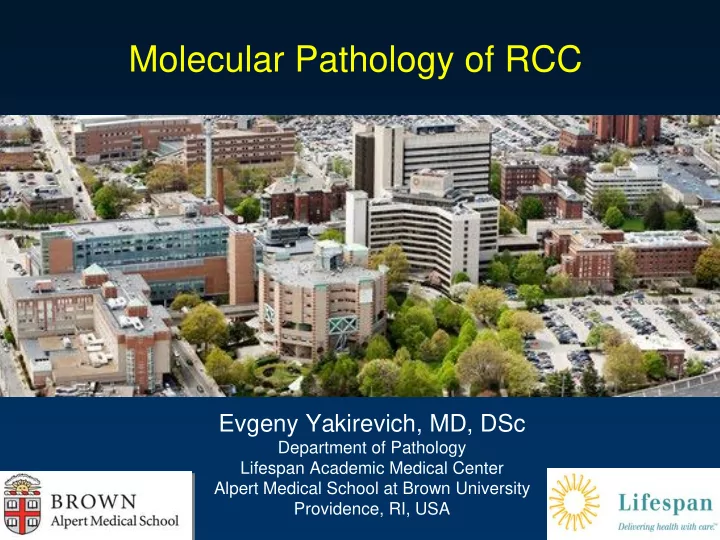

Molecular Pathology of RCC Evgeny Yakirevich, MD, DSc Department of Pathology Lifespan Academic Medical Center Alpert Medical School at Brown University Providence, RI, USA
Financial and Other Disclosures • Off-label use of drugs, devices, or other agents: None • Data from IRB-approved human research is not presented I have the following financial interests or Disclosure code relationships to disclose: No financial relationships N 2
Outline • Molecular pathology of main histologic subtypes of RCC: – Clear cell RCC – Papillary RCC – Chromophobe RCC • Molecular pathology of rare histologic subtypes of RCC – Collecting duct/Medullary – MiT family translocation carcinoma • Molecular pathology of unclassified RCC
Most Common Histologic Types of RCC • Clear cell renal cell carcinoma 70% • Multilocular cystic renal neoplasm of low malignant potential • Papillary renal cell carcinoma 15% • Hereditary leiomyomatosis and renal cell carcinoma-associated renal cell carcinoma • Chromophobe renal cell carcinoma 5% • Collecting duct carcinoma • Renal medullary carcinoma • MiT Family translocation renal cell carcinomas • Succinate dehydrogenase-deficient renal cell carcinoma • Mucinous tubular and spindle cell carcinoma • Tubulocystic renal cell carcinoma • Acquired cystic disease associated renal cell carcinoma • Clear cell papillary renal cell carcinoma • Renal cell carcinoma, unclassified • Papillary adenoma • Oncocytoma
Clear Cell RCC Clear cytoplasm – lipid, glycogen Prominent blood vessels
VHL and Chromatin Remodeling Genes Alterations in Clear Cell RCC Additional mutations Chromatin remodeling genes Somatic mutation or PBRM1 Deletion on 3p epigenetic SETD2 BAP1 silencing of on 3p VHL gene VHL +/+ VHL +/- VHL -/- VHL -/- KDM5C Clear cell RCC In 90% of sporadic cases
Abnormal VHL Protein Causes Accumulation of Hypoxia Inducible Factor- a ( HIF- a) TCEB1 VEGF PDGF TGF- a
TCEB1 -mutated RCC • 11 tumors with clear cell cytology from Sato and TCGA (Hakimi et al 2015) • Lack of 3p loss and VHL mutations • Loss of chromosome 8 containing TCEB1 • Hotspot mutations in VHL-binding site Tyr79 • Thick fibromuscular bands • Low grade and indolent behavior
RCC with TCEB1 -mutated RCC Angioleiomyomatous Hakimi et al 2015 stroma
Papillary RCC • 15% of RCC • Two histologic subtypes: – Type 1 – Type 2 (not a single entity, but remains a useful morphologic descriptor) • Subset with mixed histology
Papillary RCC Type 1 Papillary RCC Type 2
Multiplatform-Based Subtype Discovery in Papillary Renal-Cell Carcinoma Type 2 papillary RCC – at least 3 different entities genetically The Cancer Genome Atlas Research Network. N Engl J Med 2016, 374:135-45.
MET Alterations in Papillary Carcinoma • 161 tumors in TCGA cohort – 17% in type 1 – 2% in type 2 • 169 Advanced papillary RCC analyzed by CGP at Foundation Medicine (Pal et al 2018) – 33% in type 1 – 7% in type 2
Chromophobe RCC • Hypodiploid DNA: -1,- 2,-6,- 10 ,-13,- 17 ,-21 (Multiple chromosomal losses) • TP53 mutation (chr 17 ) in 30% • PTEN mutation (chr 10 ) in 10% • Folliculin (FLCN) mutations are rare
Collecting Duct Carcinoma and Renal Medullary Carcinoma Collecting Duct Renal Medullary Carcinoma Carcinoma Age 43-63 years 2-3 decade Association Sickle cell trait/disease Location Medulla Medulla; Right kidney Histology Infiltrative growth Desmoplastic stromal reaction Prognosis Poor Poor Molecular NF2 (29%) SMARCB1/INI1 alterations SETD2 (24%) inactivation (100%) SMARCB1/INI1 (18%) SDKN2A (12%) Pal et al 2016
Renal Medullary Carcinoma Infiltrating Necrosis Rhabdoid SMARCB1/(INI1) loss
MiT Family Translocation RCC • MiT – Microphtalmia/TFE gene family 1) Xp11 translocation RCC ( TFE3 fusion) – Was included in 2004 WHO classification 2) t(6;11) RCC ( MALAT1 - TFEB fusion) – New in 2016 WHO classification
MiT Family Translocation RCC 1) Xp11 Translocation RCC • 40% of pediatric RCC • 1.6-4% of adult RCC (overall adults>children) • F>M (3.7:1) • Survival is similar to clear cell RCC • Children have a better prognosis than do adults • Adults often with advanced disease and distant mets
Xp11 Translocation RCC
Xp11 Translocation RCC Fusion Age Translocation ASPL-TFE3 1-75 t(X;17)(p11.2;q25 PRCC-TFE3 2-69 t(X;1)(p11.2;q21) SFPQ-TFE3* 5-68 t(X;1)(p11.2;p34) NONO-TFE3* 29-51 inv(X)(p11.2;q12) CLTC-TFE3 14 t(X;17)(p11.2;q23) PARP14-TFE3 32 t(X;3(p11.2;q23) DVL2-TFE3 73 t(X;17)(p11;p13) * Typically show subnuclear vacuoles mimicking clear cell papillary RCC Argani AJSP 2016
Clear Cell Papillary RCC Xp11 Trans location RCC SFPQ-TFE3 Argani AJSP 2016
IHC and Molecular Studies • TFE3 IHC (nuclear) is the TFE3 most sensitive and specific (but highly fixation dependent) • Cathepsin-K + in 60% Cathepsin-K • FISH with TFE3 break- apart probe
MiT Family Translocation RCC 2) t(6;11) Renal Cell Carcinoma • MALAT1-TFEB gene fusion • >50 reported cases • Young adults, mean age 31y • More indolent • Biphasic low-grade morphology • IHC: TFEB+ (highly fixation dependent), MelanA and HMB45+, Cathepsin-K+ • TFEB break apart FISH
t(6;11) RCC: Biphasic morphology
TFEB -amplified RCC • Recently described, not in 2016 WHO • Aggressive • Variable morphology • First case Peckova et al in 2014 • 8 cases Argani et al AJSP 2016 • 9 cases Williamson et al AJSP 2017 • 11 cases Gupta et al Mod Pathol 2017 TFEB with VEGFA (6p21.1) co- amplification – potential for clinical management
Unclassified RCC • Is not a distinct subtype of RCC • Histology does not fit into any of the recognized subtypes • 62 unclassified RCC molecular analysis (Ying-Bei Chen, 2016) – Recurrent somatic mutations in 76% cases in 29 genes, including • NF2 (18%) • SETD2 (18%) • BAP1 (13%) • KMT2C (10%) • MTOR (8%) • FH deficiency 6% • ALK translocations 2%
Conclusions • Histologic subtypes of RCC have distinct molecular alterations from large deletions to point mutations and translocations • Some molecular alterations (Xp11 and t(6;11) translocations, INI-1 loss) are helpful diagnostic markers • Molecular alterations could have therapeutic implications
Recommend
More recommend